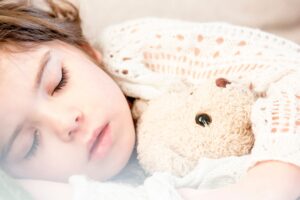Welcome back! The last few weeks we’ve been talking about the four most common causes of sleep problems and what you can do to fix them. This week we are going to focus on sleep dependencies, a common problem that most people don’t even know exists! Sleep dependencies are anything that someone needs to have with them/around them to fall asleep. Sleep dependencies can be things like a pacifier, a blanket, a stuffed animal, a parent, a cell phone, music, noise, silence, or even TV. There are some sleep dependencies that are healthy because they help you to fall asleep fast and stay asleep, but there are many sleep dependencies that are unhealthy- even though they might help you fall asleep initially, they make you wake up later in the night.
What makes a sleep dependency healthy/unhealthy?
Sleep dependencies aren’t a bad thing in and of themselves, so in any sleep treatment, we want to make sure the person has one or two healthy sleep dependencies. But we also have to look out for unhealthy sleep dependencies and when we spot those, we have to figure out how to get rid of them as soon as we can.  Healthy sleep dependencies have three qualities: they are something you have with you for the entire night, they stay the same for the entire night, and they are available every night. Some examples of healthy sleep dependencies might be a stuffed animal, a blanket, a certain pillow, darkness, or white noise. Unhealthy sleep dependencies are things that don’t stay with you the whole time you are sleeping, change while you are sleeping, or aren’t available every night. Some examples of unhealthy sleep dependencies are things like electronic devices, TVs on sleep timers, pets, and even other people.
Healthy sleep dependencies have three qualities: they are something you have with you for the entire night, they stay the same for the entire night, and they are available every night. Some examples of healthy sleep dependencies might be a stuffed animal, a blanket, a certain pillow, darkness, or white noise. Unhealthy sleep dependencies are things that don’t stay with you the whole time you are sleeping, change while you are sleeping, or aren’t available every night. Some examples of unhealthy sleep dependencies are things like electronic devices, TVs on sleep timers, pets, and even other people.
Why are sleep dependencies important?
The reason we want all good sleepers to have healthy sleep dependencies that stay with you the whole night and stay the same all night is to help you stay asleep. Interestingly, in our normal sleep cycle throughout the night, we actually have these little “micro-awakenings” a few times a night (a totally normal and healthy part of the sleep cycle). You can think of these “micro-awakenings” as a fail-safe where your brain just clicks on momentarily to make sure everything is safe, and then immediately clicks back off if things are good. When our environment, including our sleep dependencies, remains the same all night, our brain will turn on, quickly give the “all clear” and go right back to sleep; nothing to worry about here! But if we fall asleep with things that don’t stay with us or stay the same for the whole night, when our brain does that quick check-in it will sound the alarm bells- “Something has changed!! Wake up!” and we will have a full-blown waking, and will often need to get our sleep dependency back. For example, if a child falls asleep with a parent lying with them, then the parent sneaks out of the room once they’re asleep, it is likely that when they have a micro-awakening their brain will sound the alarm bell and fully wake them, and they’ll go searching for the parent again.
What do we do about sleep dependencies?
It’s important to think about what things your child’s (or your) sleep might be dependent on, and try to get rid of unhealthy sleep dependencies. Your goal is to ensure everything in the environment stays the same all night. I know this is a tough one, but generally, I recommend getting all electronics out of the bed/bedroom, for both adults and children- they are never healthy sleep dependencies! Replace unhealthy sleep dependencies with healthy ones like darkness (use blackout shades), white noise, stuffed animals (those are ok for adults too!), special blankets, or special pillows.
It’s also important, especially with very young children, to put them into bed when they are sleepy, but not already asleep. We want them to practice falling asleep in bed and practice falling asleep on their own if they sleep alone. So if your child sleeps in their own bed by themselves, try not to lay down with them while they are falling asleep, because that is a guaranteed way to make sure that when they have those micro-awakenings in the middle of the night they won’t be able to fall back to sleep and will come looking for you. We will talk more about getting rid of parents as a sleep dependency in an upcoming week, so stay tuned!
Now what?
If you need help assessing your sleep dependencies or your child’s sleep dependencies, contact me! We can do an assessment to help figure out whether unhealthy sleep dependencies might be to blame for pesky sleep problems. During sleep treatment, I take a gentle approach to getting rid of sleep dependencies, no “cry-it-out” or going “cold turkey” here! Feel free to drop me a note if you need some help, and stay tuned for future blog posts where we will go further in-depth on how to gently fade out sleep dependencies.